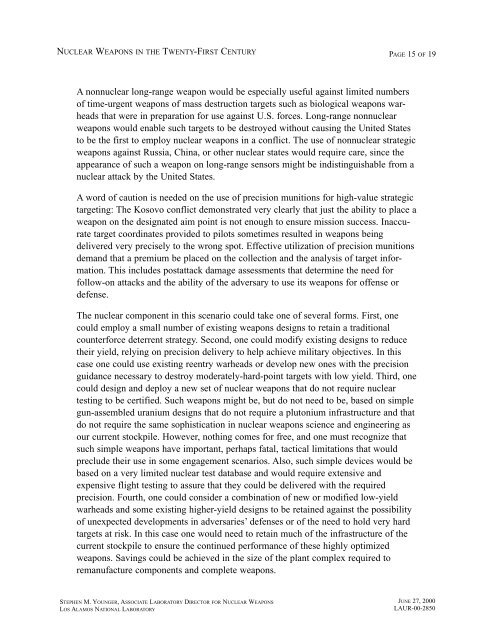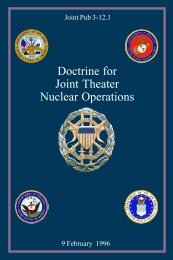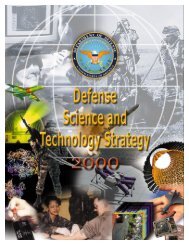Nuclear Weapons in the Twenty-First Century - Sciencemadness.org
Nuclear Weapons in the Twenty-First Century - Sciencemadness.org
Nuclear Weapons in the Twenty-First Century - Sciencemadness.org
Create successful ePaper yourself
Turn your PDF publications into a flip-book with our unique Google optimized e-Paper software.
NUCLEAR WEAPONS IN THE TWENTY-FIRST CENTURY<br />
PAGE 15 OF 19<br />
A nonnuclear long-range weapon would be especially useful aga<strong>in</strong>st limited numbers<br />
of time-urgent weapons of mass destruction targets such as biological weapons warheads<br />
that were <strong>in</strong> preparation for use aga<strong>in</strong>st U.S. forces. Long-range nonnuclear<br />
weapons would enable such targets to be destroyed without caus<strong>in</strong>g <strong>the</strong> United States<br />
to be <strong>the</strong> first to employ nuclear weapons <strong>in</strong> a conflict. The use of nonnuclear strategic<br />
weapons aga<strong>in</strong>st Russia, Ch<strong>in</strong>a, or o<strong>the</strong>r nuclear states would require care, s<strong>in</strong>ce <strong>the</strong><br />
appearance of such a weapon on long-range sensors might be <strong>in</strong>dist<strong>in</strong>guishable from a<br />
nuclear attack by <strong>the</strong> United States.<br />
A word of caution is needed on <strong>the</strong> use of precision munitions for high-value strategic<br />
target<strong>in</strong>g: The Kosovo conflict demonstrated very clearly that just <strong>the</strong> ability to place a<br />
weapon on <strong>the</strong> designated aim po<strong>in</strong>t is not enough to ensure mission success. Inaccurate<br />
target coord<strong>in</strong>ates provided to pilots sometimes resulted <strong>in</strong> weapons be<strong>in</strong>g<br />
delivered very precisely to <strong>the</strong> wrong spot. Effective utilization of precision munitions<br />
demand that a premium be placed on <strong>the</strong> collection and <strong>the</strong> analysis of target <strong>in</strong>formation.<br />
This <strong>in</strong>cludes postattack damage assessments that determ<strong>in</strong>e <strong>the</strong> need for<br />
follow-on attacks and <strong>the</strong> ability of <strong>the</strong> adversary to use its weapons for offense or<br />
defense.<br />
The nuclear component <strong>in</strong> this scenario could take one of several forms. <strong>First</strong>, one<br />
could employ a small number of exist<strong>in</strong>g weapons designs to reta<strong>in</strong> a traditional<br />
counterforce deterrent strategy. Second, one could modify exist<strong>in</strong>g designs to reduce<br />
<strong>the</strong>ir yield, rely<strong>in</strong>g on precision delivery to help achieve military objectives. In this<br />
case one could use exist<strong>in</strong>g reentry warheads or develop new ones with <strong>the</strong> precision<br />
guidance necessary to destroy moderately-hard-po<strong>in</strong>t targets with low yield. Third, one<br />
could design and deploy a new set of nuclear weapons that do not require nuclear<br />
test<strong>in</strong>g to be certified. Such weapons might be, but do not need to be, based on simple<br />
gun-assembled uranium designs that do not require a plutonium <strong>in</strong>frastructure and that<br />
do not require <strong>the</strong> same sophistication <strong>in</strong> nuclear weapons science and eng<strong>in</strong>eer<strong>in</strong>g as<br />
our current stockpile. However, noth<strong>in</strong>g comes for free, and one must recognize that<br />
such simple weapons have important, perhaps fatal, tactical limitations that would<br />
preclude <strong>the</strong>ir use <strong>in</strong> some engagement scenarios. Also, such simple devices would be<br />
based on a very limited nuclear test database and would require extensive and<br />
expensive flight test<strong>in</strong>g to assure that <strong>the</strong>y could be delivered with <strong>the</strong> required<br />
precision. Fourth, one could consider a comb<strong>in</strong>ation of new or modified low-yield<br />
warheads and some exist<strong>in</strong>g higher-yield designs to be reta<strong>in</strong>ed aga<strong>in</strong>st <strong>the</strong> possibility<br />
of unexpected developments <strong>in</strong> adversaries’ defenses or of <strong>the</strong> need to hold very hard<br />
targets at risk. In this case one would need to reta<strong>in</strong> much of <strong>the</strong> <strong>in</strong>frastructure of <strong>the</strong><br />
current stockpile to ensure <strong>the</strong> cont<strong>in</strong>ued performance of <strong>the</strong>se highly optimized<br />
weapons. Sav<strong>in</strong>gs could be achieved <strong>in</strong> <strong>the</strong> size of <strong>the</strong> plant complex required to<br />
remanufacture components and complete weapons.<br />
STEPHEN M. YOUNGER, ASSOCIATE LABORATORY DIRECTOR FOR NUCLEAR WEAPONS<br />
LOS ALAMOS NATIONAL LABORATORY<br />
JUNE 27, 2000<br />
LAUR-00-2850






